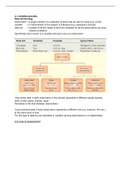Zusammenfassung
Statistics book summary
- Kurs
- Hochschule
- Book
I have made a summary of all the chapters/content we had to learn for the Business Statistics exam. It is an open book exam but studying this still helped me save time during the exam.
[ Mehr anzeigen ]





